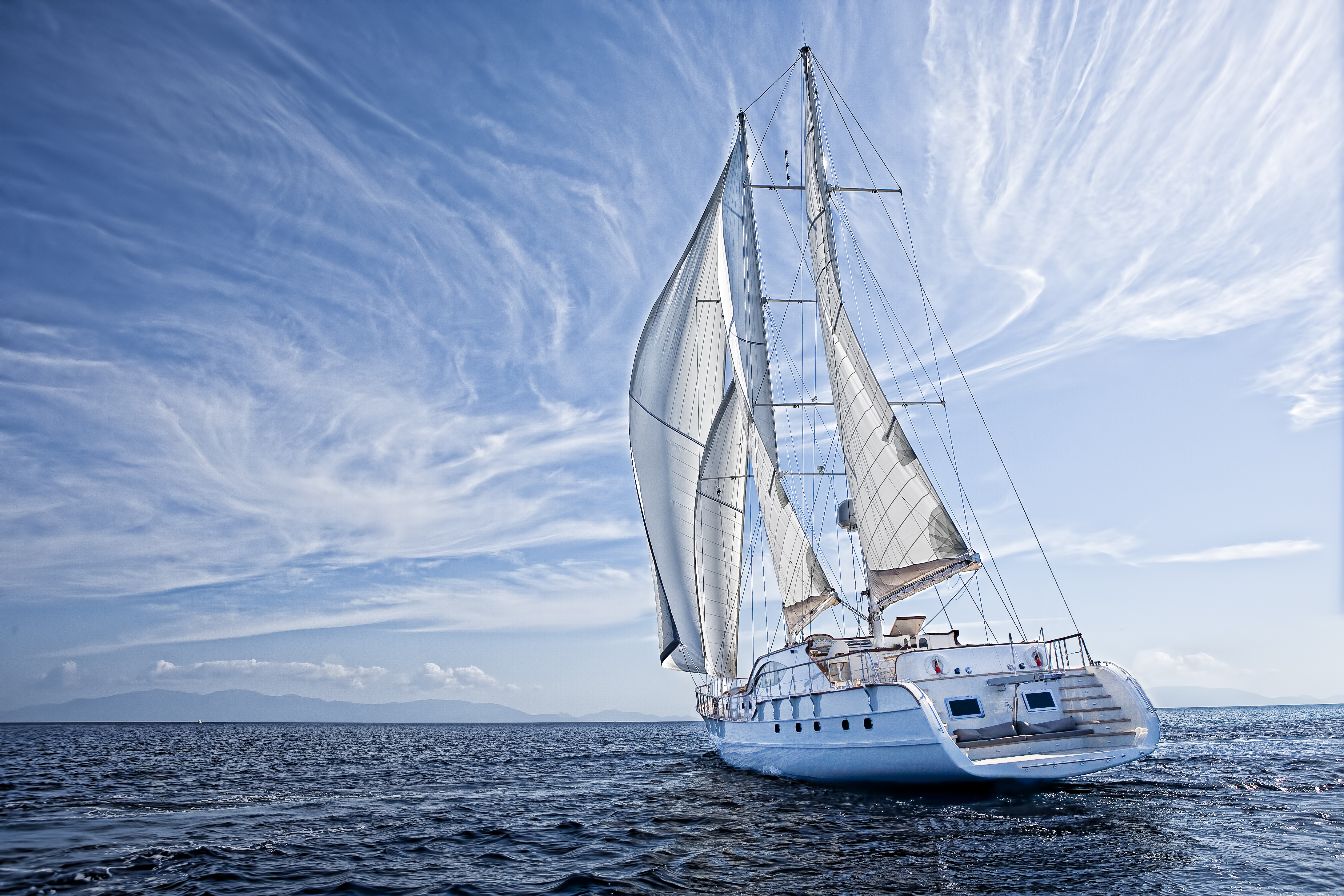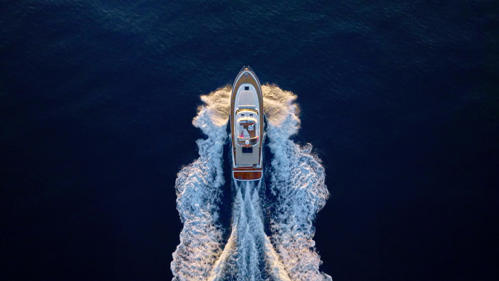Parts of a yacht: Essential terms you need to know
15 July 2025

Whether you’re a yacht owner or thinking about buying your first yacht, understanding the anatomy of a boat is important to ensure you travel safely. With so many parts of a yacht to consider, remembering all of the different terms can be a challenge.
In this guide, we’ll look at what constitutes a yacht. We’ll also highlight the main parts of a yacht with descriptions about what each feature does to help you understand its complex anatomy.
What is a yacht?

A yacht is a watercraft typically used for leisure cruises, entertaining, and living aboard while on holiday.
While yachts have many of the same features as a boat, they’re usually larger, more luxurious, and have high-end amenities, such as spacious cabins and unique entertainment areas.
Yachts aren’t defined by their size, but they tend to be at least 25ft long and can measure up to hundreds of feet in length. Large yachts may be referred to as ‘superyachts’ while even bigger vessels are often known as ‘mega yachts’. The main reason that yachts are typically large in size is that they need to be able to accommodate a range of luxurious facilities.
There are different types of yacht, including:
- Sailing yacht: A yacht that’s mainly propelled via wind and sails
- Motor yacht: A yacht that’s propelled by one or more motors
- Gulet yacht: A hybrid yacht with sails and motors
- Cruising yacht (also called a cruiser, cabin cruiser, express cruiser): A type of yacht used for cruising and entertaining
- Luxury yacht: Featuring high-end finishes and the latest technology. Luxury yachts can be both sailing and motor yachts
- Sports yacht: A vessel geared towards sports like fishing or water sports
- Catamaran: Catamarans have two hulls and are often made of fibreglass. They can be used in shallow waters
Understanding the main parts of a yacht

Yachts are made up of a whole range of different parts, each with its own important function. The parts of a yacht differ slightly from the parts of a sailing boat, depending on the type of yacht and what it’s used for.
Generally speaking, the main yacht parts include:
Aft – The aft is the rear of the yacht. A yacht may also have an aft deck or aft cabin, which sits at the back of the vessel.
Anchor – Typically made of metal, an anchor is a heavy object that’s dropped down to the seabed to secure the yacht and stop it from floating away. The size and type of anchor you need will depend on the yacht you have.
Beam - The beam of a yacht is its width at the widest part of its hull. The wider your yacht’s beam, the more space you’ll have and the more stable your vessel will be. However, some ports and harbours have beam restrictions, so consider this before choosing where to dock.
Berth – When discussing boat anatomy, a berth is a designated sleeping area. Yacht berths tend to be more spacious and luxurious than those found on boats.
Bow – The front of a yacht is called the bow and is specifically designed to help the vessel travel with limited resistance.
Bridge – The bridge of a yacht is where the vessel’s controls and navigation equipment can be found. This is where the captain and crew control the yacht and communicate with others.
Cabin – A cabin is a private room on a yacht that typically features a bed and storage. The amenities you’ll find in a cabin will depend on the yacht.
Cleat - A cleat is a solid fixture used to secure lines to a yacht to keep them in place. Lines may be used for anchoring, docking, or managing the sails.
Deck - The deck is the floor area that sits above the hull and provides space for walking and other leisure activities. A strong deck is key to ensure a yacht is sturdy.
Draft – A yacht’s draft refers to the distance between the waterline and the bottom of the vessel’s hull. A yacht with a shallow draft can navigate shallow waters well, whereas a large draft is better for stability in rough conditions.
Galley – The galley is the yacht’s kitchen and has all you need for food preparation and cooking.
Gunwale – Gunwale refers to the edge where a yacht’s hull meets its deck. This is important for structural reinforcement and provides a handrail for those walking on the deck. Cleats can be securely attached to it too.
Hatch – Hatches provide access to the interior of the yacht from its deck or hull. They’re watertight to prevent water from leaking in, and some yachts have multiple hatches.
Head – A yacht’s head is its toilet or bathroom. It’s referred to as the head as, historically, a boat’s toilet would be located towards the front of the vessel.
Helm - The helm is the steering wheel or tiller used to steer and manoeuvre the yacht.
Hull – The hull is the main body of the yacht and is designed to ensure the vessel remains buoyant and watertight.
Keel – A yacht’s keel is attached to the bottom of its hull and is important for stability.
Line – Line refers to any rope used on a yacht. Efficient knots need to be tied to ensure lines remain secure.
Mast – The mast is a tall, vertical pole that supports a yacht’s sails and rigging. A yacht may have more than one mast depending on its size, and masts can be made from a variety of different materials.
Port – Port is the left-hand side of a yacht when you’re facing the front of the vessel.
Porthole – A yacht window is called a porthole. Portholes are required for light and ventilation, although some are fixed and cannot be opened.
Propellers – Propellers, found on motorised yachts, are rotating blades that move the vessel through the water.
Rig – A yacht’s rig refers to everything the yacht requires to be propelled by the wind. This includes the sails, masts, and rigging.
Rigging – Rigging is the combination of ropes, wires, and hardware used to control the yacht’s sails.
Sail – The sail of a yacht is a large piece of strong, durable fabric attached to the mast using rigging. The sail catches the wind, which enables the yacht to move through the water. There are numerous types of yacht sails, and a vessel can have more than one.
Starboard – Starboard is the right-hand side of a yacht when you’re facing the front of the vessel.
Stern – The yacht’s stern is the back of the hull. The back of any boat is called the stern.
Specialist yacht insurance through GJW Direct
Now you know about the anatomy of a boat and the different parts of a yacht, you may want to consider specialist yacht insurance to ensure your vessel is safe and secure.
Get an instant online quote for yacht insurance today.
Please note the information provided on this page should not be taken as advice and has been written as a matter of opinion. For more on insurance cover and policy wording, see our homepage.
Got a question? Call our UK call centre 0151 473 8000
©Copyright Ripe Thinking Limited 2025. GJWDirect® is a registered trademark and a trading name of Ripe Insurance Services Limited which is Authorised and Regulated by the Financial Conduct Authority No.313411.
Registered office: One Stockport Exchange, Railway Road, Stockport, United Kingdom, SK1 3SW. Registered in England No. 04507332.
